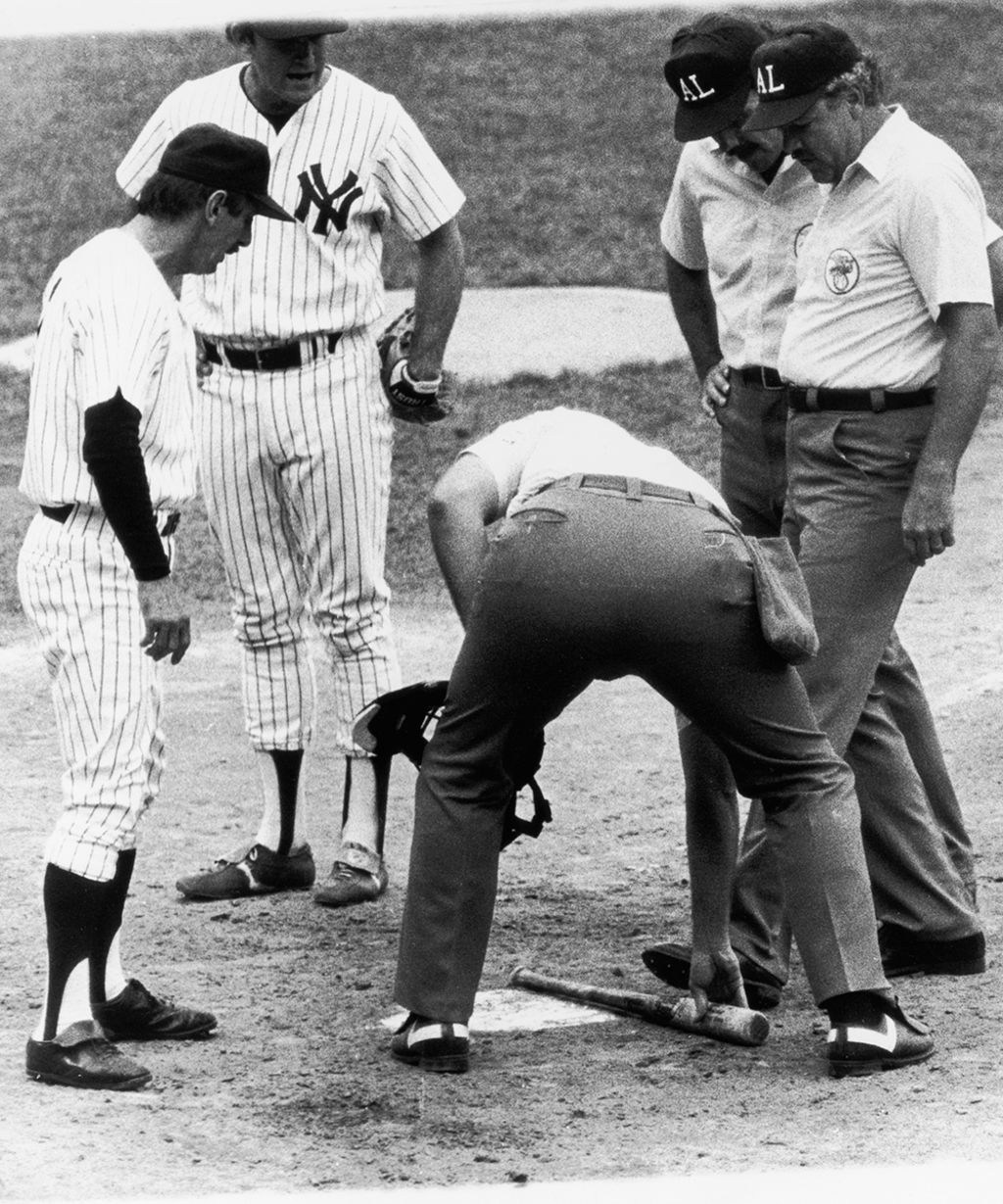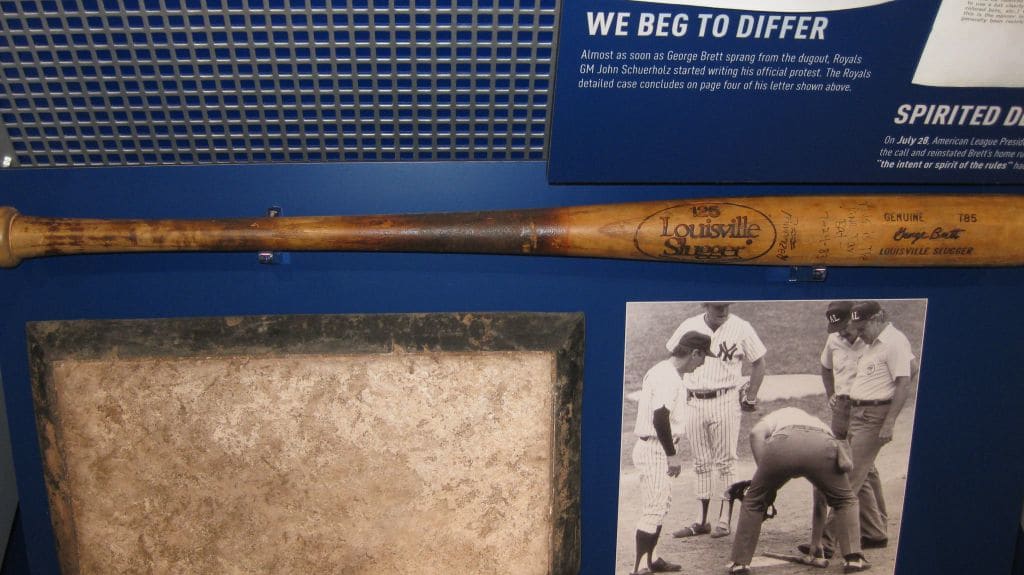The headline in the July 29 afternoon edition of The Kansas City Star was an ecstatic one: “It’s a homer, by George!” But this was not your grandfather’s home run, though your grandfather can probably retell the story well; it would take the work of league officials and state Supreme Court justices, lawsuits, signed affidavits and political fixers to make this long ball officially stand up. On either end of it were two teams who did not like one another, and George Brett was the Kansas City star stuck in the middle.
Rewind to July 24, 1983, a tilt in the Bronx between the Yankees and Royals that now goes by only one name: The Pine Tar Game. There was always a David and Goliath feel to this matchup between an East Coast powerhouse and the Midwestern younger brother it had beaten in three straight ALCS from 1976-78. So when George Brett came to bat with two outs in the ninth and K.C. trailing by a run, manager Billy Martin decided to bring in his future Hall of Fame closer, Goose Gossage.
Brett was already a perennial All-Star at this point in his career and had won the AL MVP Award in 1980, so it wasn’t a complete shock when the man who never wore batting gloves took Gossage deep to put the Royals up, 5-4. Brett’s preference for pine tar over batting gloves is only a relevant detail because of the infamous confluence of events that came next. While Brett was making his trip around the bases thinking he had just hit a clutch go-ahead blast, the always hot-headed Martin was conferring with home-plate umpire Tim McClelland about Brett’s bat.
The issue in question was how much pine tar, a sticky substance used to aid grip of the bat, was visible on the handle. Official Rule 1.10 (b) states that no substance can cover the handle more than 18 inches from the end, and if any substance extends past that limit, “in the umpire’s judgment,” the bat would be removed from the game. The umpire’s judgment mention is important to note here, because this was no exact science. There was no tape measure or ruler at their disposal, so the crew had to improvise. Not unlike NFL officials measuring the placement of the football to move the chains, the umps put the bat across home plate, which is 17 inches in width, and determined the pine tar extended past 18 inches.

McClelland then walked over to the Kansas City dugout, pointed the handle of the bat at the row of seated players waiting to hear his call and raised his fist to signal an out. Brett immediately leaped to his feet and stormed back onto the field, headed straight at McClelland like a bull seeing red. Just watch the video; it doesn’t take an expert lip reader to ascertain the words coming out of his mouth.
While all that was taking place on the field, there was a Mission Impossible-style operation going on behind the scenes as the Royals tried to whisk away the bat in question to prevent it from getting into the hands of league officials. Pitcher Gaylord Perry, no stranger to accusations of doctoring the baseball when he was on the mound, was the leader of that failed mission.
“Gaylord got the bat and passed it back and tried to get it to the clubhouse,” crew chief Joe Brinkman said. “The security people went after it.”
The bat now has a home in the Royals Hall of Fame, but before it got there it was the heart of controversy in the league offices, where American League president Lee MacPhail was tasked with making a ruling on the Royals’ protest of McClelland’s decision to call Brett out. The issue was a divisive one that elicited strong opinions on both sides, including from a former president and New York resident.

“Dear George,” Richard Nixon wrote in a letter to Brett. “As one who roots for the home team I am a Yankee fan. As a long time George Brett fan I thought you got a lousy deal. I'll wager they change the rule in the future. In the meantime - Keep slugging."
Nixon was right, because MacPhail ultimately ruled that too much pine tar on the bat, while by definition illegal, was not grounds to negate a home run.
“Games should be won and lost on the field – not through technicalities of the rules,” he said, declaring the home run should stand and the ninth inning should be resumed to complete the game.
That could have been the end of it right there, but these were George Steinbrenner’s mighty Yankees, who never shied away from a fight. Steinbrenner was incensed at MacPhail’s decision and, let’s just say, pretty outspoken about it.
“If the Yankees should lose the Eastern Division race on the ruling of American League President Lee MacPhail, I would not want to be poor Lee living in New York City,” Steinbrenner said. “He better start house hunting in Missouri, close to Kansas City.”
Even Brett, on the right side of the ruling, had to admit that it took gumption.
“I think it showed a lot of courage,” Brett said. “He’s a native New Yorker and he lives there. I would not have wanted to make that decision.”
But in New York parlance, it wasn’t quite time to fuhgeddaboudit and move on, at least not in Steinbrenner’s mind. He hired famous attorney and notorious political fixer Roy Cohn and took MacPhail’s ruling to resume the game in the ninth inning to the courts. On Aug. 18, 26 days after the first pitch was thrown and following multiple lawsuits, Appellate Justice Joseph Sullivan overturned a New York Supreme Court injunction against the resumption of the game. Justice Sullivan ruled in favor of the AL president and ordered the game to be finished that night.
The Royals arrived to a “ghost town” of a stadium, according to Bud Black, who had been the starting pitcher of the original game
“It was weird. Usually at Yankee Stadium there’s electricity,” Black said. “But there was maybe 100 people in the stands waiting to get the four outs.”
Those four outs took all of 10 minutes, with Dan Quisenberry closing the door on the Yankees in the bottom half. Hardly anybody was there to see it, but by George the Royals had finally, officially won.
A Hall of Fame career’s worth of accolades never stopped Brett from being asked about that one sticky bat and the iconic story that sticks with us still today.
“If it happened in Cleveland,” Brett once said, “it’s not that big of a deal.”


